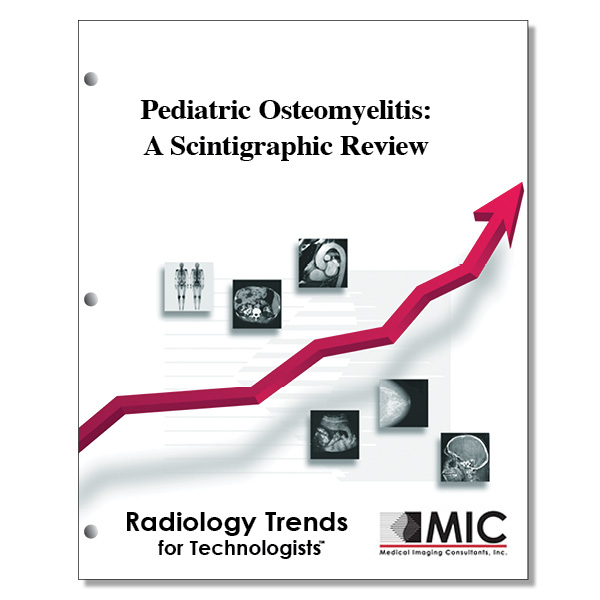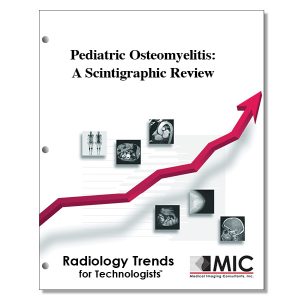

Pediatric Osteomyelitis: A Scintigraphic Review
This review presents techniques to optimize bone scintigraphy for evaluation of a spectrum of abnormalities associated with pediatric osteomyelitis.
Course ID: Q00343 Category: Radiology Trends for Technologists Modalities: Nuclear Medicine, Radiography2.5 |
Satisfaction Guarantee |
$29.00
- Targeted CE
- Outline
- Objectives
Targeted CE per ARRT’s Discipline, Category, and Subcategory classification:
Nuclear Medicine Technology: 2.50
Procedures: 2.50
Other Imaging Procedures: 2.50
Registered Radiologist Assistant: 2.50
Procedures: 2.50
Musculoskeletal and Endocrine Sections: 2.50
Outline
- Introduction
- Imaging Modalities
- Scintigraphic Protocol
- Special Pediatric Considerations
- Pathophysiology
- Neonates
- Differential Diagnosis
- Conclusions
Objectives
Upon completion of this course, students will:
- identify the most common source for osteomyelitis
- be familiar with the routes of infection for osteomyelitis
- identify the most common route of infection for osteomyelitis
- be familiar with the first imaging assessment performed for osteomyelitis
- identify which imaging modality is more suited for soft-tissue changes associated with osteomyelitis
- understand the advantages of MRI for osteomyelitis
- identify the imaging modalities that are not used for screening osteomyelitis
- understand the advantages of using bone scintigraphy for osteomyelitis
- be familiar with the time frame for osteomyelitis to appear on bone scintigraphy
- understand when to use MRI as the imaging modality for suspected osteomyelitis
- identify the goal of treatment for patients suffering from osteomyelitis
- be familiar with the traditional delivery of antibiotics to treat osteomyelitis
- identify what radiopharmaceutical is used for bone scintigraphy
- be familiar with the first phase of the triple-phase bone scintigraphy
- recognize which phase of triple-phase bone scintigraphy is definitive
- understand the role of whole-body imaging for osteomyelitis
- be familiar with the radiopharmaceutical uptake of diphosphonates
- understand the role of white blood cell scintigraphy
- be familiar with hydroxyapatite crystals
- understand the localization of bone radiopharmaceuticals in the human body
- be familiar with alternatives to 99mTc MDP for bone scintigraphy
- identify what test is used to determine quality control on 99mTc MDP
- recognize drugs that can alter biodistribution of bone imaging agents
- be familiar with radiopharmaceuticals used for PET bone scans
- be familiar with the dose administration to imaging time for a PET bone scan
- be familiar with the methods for calculating pediatric radiopharmaceutical doses
- understand who determines the need for sedation
- be familiar with the organization that provides guidelines for pediatric sedation
- be familiar with the organization that exists to minimize pediatric radiation exposure
- understand how osteomyelitis begins in pediatric patients’ long bones
- understand why microorganisms may grow in the metaphyseal capillaries
- be familiar with the characteristics of Brodie abscess
- identify the most common bacterial pathogenic cause for osteomyelitis
- be familiar with the clinical signs of osteomyelitis in neonates
- be familiar with the location of septic arthritis in children younger than 1 year of age
